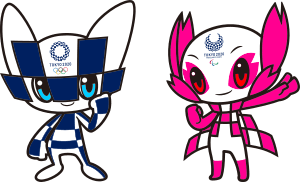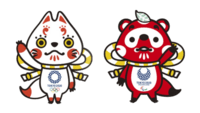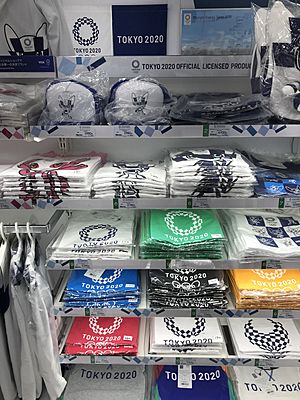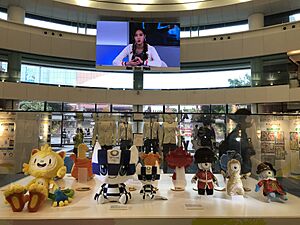Miraitowa and Someity facts for kids

Miraitowa is the official mascot for the 2020 Summer Olympics. Someity is the official mascot for the 2020 Summer Paralympics. These big sports events took place in Tokyo, Japan, in 2021.
Both mascots have a cool checkered pattern. This design was inspired by the ichimatsu moyo pattern from the Tokyo 2020 official logo. Someity's pink color comes from beautiful cherry blossoms. These two characters are fictional, but they have amazing superpowers, like being able to teleport instantly!
A Japanese artist named Ryo Taniguchi created the mascots. They were chosen after a big competition in 2017 and 2018. Over 2,000 designs were sent in. The organizers picked three pairs of mascots. Then, Japanese elementary school students voted for their favorite.
The winners were announced on February 28, 2018. The mascots got their names on July 22, 2018. Miraitowa's name combines Japanese words: mirai ("future" (未来)) and towa ("eternity" (永久)). Someity's name comes from someiyoshino, a type of cherry blossom. It also sounds like the English phrase "so mighty" (meaning "very strong"). These mascots were also meant to help raise money for the Tokyo Games by selling toys and other items.
Contents
How the Mascots Were Chosen
Picking the Designs
The Tokyo 2020 organizers held a contest to find the best mascot designs. This happened in late 2017 and early 2018. People sent in 2,042 designs between August 1 and August 14, 2017. Experts then looked at these designs. They wanted to make sure the mascots would appeal to kids. They also checked if the designs showed the spirit of the Tokyo 2020 Games.
By mid-October 2017, only three pairs of mascots were left. Each pair had one mascot for the Olympics and one for the Paralympics. These final designs were shown on December 7, 2017.
The School Vote
From December 11, 2017, to February 22, 2018, a special election took place. Over 16,000 Japanese elementary schools participated. Each class got one vote. In total, 205,755 elementary school classes voted. This was about 75% of all elementary schools in Japan!
| Pair | Designer | Votes received | Profile |
|---|---|---|---|
| A (winner) | Ryo Taniguchi (Japanese: 谷口亮) | 109,041 | |
| B | Kana Yano (Japanese: 矢野花奈) | 61,423 | |
| C | Sanae Akimoto (Japanese: 秋本早苗) | 35,291 |
The winning designs were announced on February 28, 2018. They were pair A, created by Ryo Taniguchi.
Naming the Mascots
After the designs were chosen, a group of experts picked names. They voted on a list of suggested names on May 28, 2018. The names with the most votes were checked to make sure no one else owned them.
The names, Miraitowa and Someity, were officially announced on July 22, 2018. This happened when the mascots appeared for the first time at a special event.
Mascot Features
Miraitowa: The Olympic Mascot
Miraitowa is the mascot for the Olympics. It has blue-checkered patterns. These patterns are inspired by the Games' official logo. The checkered design, called ichimatsu moyo, was popular in Japan during the Edo period (1603 to 1867). Miraitowa is meant to show both old Japanese traditions and new ideas.
This character has a strong sense of fairness. It is also very athletic. Miraitowa can teleport anywhere in an instant! Its name combines "future" (mirai) and "eternity" (towa). The organizers said the name was chosen to give people hope for a bright future.
Someity: The Paralympic Mascot

Someity is the mascot for the Paralympics. It has pink-checkered patterns. These patterns are inspired by cherry blossoms and the Games' official logo. Someity is usually calm. But it can become very powerful when needed.
This character can fly using its checkered cape. It can also send telepathic messages with its cherry blossom-shaped antennae. Someity can even "talk to stones and the wind." It can also move objects just by looking at them! Someity's name comes from someiyoshino, a type of cherry blossom. Its name also sounds like "so mighty" in English.
Their Friendship
Even though Miraitowa and Someity have different personalities, they are great friends. They respect each other a lot. In their made-up story, they "live in the digital world." They can travel between the digital world and the real world using the internet.
Some experts say these mascots follow a Japanese tradition. This tradition involves giving personalities to things in nature, like mountains, rivers, animals, and plants. It's like believing that everything in nature has a soul.
The Artist Behind the Mascots
The mascots were designed by a Japanese artist named Ryo Taniguchi. He lives in the Fukuoka Prefecture in southern Japan. His father, who is also an artist, encouraged him to study art in California. Ryo Taniguchi has also drawn pictures for English textbooks used by Japanese children.
Taniguchi found out about the Tokyo 2020 mascot contest on Facebook in February 2017. He first thought of a character whose head looked like a samurai helmet. It would have the ichimatsu moyo pattern from the Tokyo 2020 logo. After making a rough drawing, he changed his design to fit the contest rules. When designing the mascots, Taniguchi focused on their eyes to make them special.
Ryo Taniguchi was not involved in choosing the mascots' names. He did attend a meeting where different names were suggested. When he agreed to let his designs be used, he gave the rights to the mascots to the Olympic and Paralympic committees. This means he won't get paid extra money from things like mascot toys or other merchandise.
Mascots in Media
Merchandise
The mascots were expected to help raise money for the Tokyo Games. An Olympic official thought the mascots could bring in a lot of money from selling licensed products. After the Games are over, the rights to the mascots go to the International Olympic Committee and the International Paralympic Committee. This means Tokyo cannot sell or develop the mascots anymore after the Games.
From late July to early September 2018, there was a "Mascot House" in Tokyo. Visitors could take pictures with the mascots and buy official merchandise. On July 11, 2019, new mascot items were shown. You can buy these items online or at stores across Japan.
Small plush dolls of Miraitowa and Someity were given to Olympic and Paralympic medal winners. These dolls were attached to their flower bouquets. The mascots' "armor" matched the color of the athlete's medal (gold, silver, or bronze).
Robotics
On July 22, 2019, the organizers announced that robot versions of Miraitowa and Someity would be at the Games. These robots were made to show facial expressions. They could wave at and shake hands with athletes and fans. The robots were mainly used to promote the Games and greet visitors. This was a way to get kids more excited.
The robots were also part of a "1 Year to Go" event in Tokyo. They appeared at a Japanese elementary school on November 18, 2019. The robots' eyes can change to show hearts and other feelings. Their many joints and arms can be controlled from far away. Cameras help the robots recognize and react to faces. Toyota helped develop these robots.
Animation
On July 22, 2019, the official Japanese Twitter account for Tokyo 2020 shared a short animated video. It showed Miraitowa taking part in all the Olympic sports. On August 25, 2019, the same Twitter account posted a similar video. This one showed Someity participating in the Paralympic Games.
See also
 In Spanish: Miraitowa y Someity para niños
In Spanish: Miraitowa y Someity para niños





